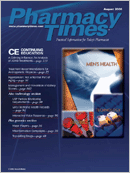Publication
Article
Pharmacy Times
Management and Prevention of Kidney Stones
Author(s):
Nephrolithiasis and urolithiasis?stones, or calculi, in the kidney or another part of the urinary tract?are among urology's most common and painful disorders. Their prevalence increased from 3.2% in the late 1970s to 5.2% in the early 1990s, suggesting lifestyle-associated risk factors1 (see sidebar1-4).
Kidney stones develop when concentrations of dissolved salts and other substances in the urine exceed normal limits and condense into solids. Initially anchored to Henle's loops inside the kidney, stones eventually dislodge, migrating to the ureters. The most common stones are comprised of calcium oxalate and calcium phosphate (80%), struvite (10%), uric acid (9%), and cystine or ammonium acid urate (1%).2
Hematuria may be the sole symptom when tiny stones, also called gravel, pass without pain. When larger stones obstruct ureters, initial discomfort escalates to severe pain within an hour. Intense renal colic occurs when ureteral spasms attempt to squeeze the stone through; these painful paroxysms can last 20 to 60 minutes. Upper ureter obstruction refers pain to the upper pelvis and ribs; patients experience lower obstruction as lower abdomen pain, sometimes radiating to the genitals.1,5 Ureter obstruction also may cause nausea, vomiting, urinary urgency and burning, and blood in the urine.
Kidney stones, like fever, are not a diagnosis but are symptoms of an underlying metabolic disorder. Often, calcium oxalate and calcium phosphate stones cannot be attributed to specific diseases. Idiopathic hypercalciuria is a frequent catchall diagnosis. It means that stone etiology is unknown, but excessive calcium is absorbed from food, raising saturation levels of urinary calcium salts.1-3 Despite unknown idiopathic etiology, stone formation has been linked to several risk factors (Table 13,6).
Diagnosis and Treatment
Small kidney stone passage can easily be confused with other conditions, especially urinary tract infection. Confusion disappears, however, when ureter obstruction and excruciating renal colic develop. An unenhanced computed tomography scan pinpointing the stone's size and location has become the gold standard for diagnosis. Treatment goals are fourfold: (1) ameliorate severe pain; (2) remove obstructing stones; (3) address confirmed underlying disorders, if any; and (4) prevent future attacks.
Nonsteroidal anti-inflammatory drugs (NSAIDs) are recommended for small stones, which often cause discomfort similar to that of a common backache. NSAIDs are rarely sufficient, and narcotics are indicated for kidney stone obstructions and renal colic. Because many patients describe ureter obstruction as the worst pain they have ever experienced, narcotics are used and prescribed at a much lower threshold for the pain's historical duration.3 Dose escalation correlates with pain severity, and extreme cases may precipitate hospital admission.
Increasing urine volume will facilitate stone passage through the ureter, and patients should drink 2 to 3 quarts of water daily. They must screen their urine and collect stones, which are then analyzed for mineral content.
Patients are very likely to pass stones less than 5 mm in diameter; modestly likely (~50%) to pass 5-to 7- mm stones; and may need intervention for those >7 mm.2 Stones that eventually pass do so within several days. Because chronic obstruction leads to eventual renal failure, stones that are not passed must be retrieved, generally by 1 of 3 procedures.
Noninvasive extracorporeal shockwave lithotripsy (ESWL) directs a high-energy shock wave at the stone, fragmenting it so that it can be passed. ESWL is ineffective, however, for very large stones.
Percutaneous nephrolithotomy, an inpatient procedure, generally is used for upper ureter obstruction. Via a small incision in the patient's back, the surgeon has direct access to the kidney and ureter for the stone's removal.
Ureteroscopy, an ambulatory outpatient procedure, is suited for lower ureter obstruction. The procedure involves the insertion of a scope and high-intensity lasers through the urethra and bladder into the ureter, allowing the surgeon to remove the intact stone or break it into smaller fragments. Open surgical procedures are reserved only for the most extreme cases.
Prevention
Prevention efforts depend on the stone's mineral content and suspected or confirmed etiology. Table 2 presents recommended pharmacologic prevention strategies.
Dietary modification helps prevent recurrence, especially for those with calcium oxalate stones. Whereas individual dietary interventions should be guided by urinary analysis, all patients will benefit from increased fluid intake. Increased fluid decreases urine salt concentration, and some practitioners recommend up to 3 or 4 quarts daily, more in hot weather. The type of fluid is important; water is highly recommended, although coffee, orange juice, and even alcohol also are beneficial.3
Limiting sodium intake to 2000 to 3000 mg reduces urinary calcium, increases urinary citrate, and reduces sodium urate saturation, all of which minimize calcium oxalate precipitation.3,6 Patients should be counseled not to reduce calcium intake, because doing so increases the risk of recurrence. Research demonstrates that normal and even high calcium diets decrease risk for calcium oxalate stone formation.6 Patients should avoid calcium supplements unless their health care provider approves. Decreasing animal protein and oxalate intake is recommended. Completely eliminating oxalate-containing foods (eg, beets, chocolate, coffee, cola, nuts, rhubarb, spinach, strawberries, tea, and wheat bran) is unnecessary.1
Final Thought
Patients should be counseled that recurrence is likely, but risk can be minimized with ongoing fluid intake, including drinking in the evening. Patients who have suffered from stone obstructions and renal colic once are often highly motivated to follow prevention guidelines.
Dr. Zanni is a psychologist and health-systems consultant based in Alexandria,Va.
For a list of references, send a stamped, self-addressed envelope to: References Department, Attn. A. Rybovic, Pharmacy Times, Ascend Media Healthcare, 103 College Road East, Princeton, NJ 08540; or send an email request to: [email protected]

Newsletter
Stay informed on drug updates, treatment guidelines, and pharmacy practice trends—subscribe to Pharmacy Times for weekly clinical insights.






